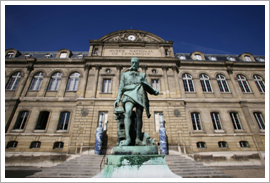|
|
 |
 |
 On January 1, 2010, the Manufacture Nationale de S├¿vres and the Mus├®e National de la C├®ramique, two departments with a domestic jurisdiction of the Ministry of Culture and Communication, were transformed into a public administrative institution, S├¿vres ÔÇô Cit├® de la C├®ramique. On January 1, 2010, the Manufacture Nationale de S├¿vres and the Mus├®e National de la C├®ramique, two departments with a domestic jurisdiction of the Ministry of Culture and Communication, were transformed into a public administrative institution, S├¿vres ÔÇô Cit├® de la C├®ramique.
In Europe, the manufactory is the last production plant that combines the rationale of public service (transmitting expertise, preserving collections of studies, producing a heritage of forms and decorations, supporting contemporary design through a policy of artist invitations and residencies) with that of ceramic production in the field of applied arts (with its economic and commercial stakes). Dedicated to the preservation of savoir-faire and of a unique heritageÔÇöthe legacy of over 250 years of historyÔÇöand driven by the acknowledged commitment and professionalism of all of its production workshops, it has revitalized itself and got in tune with its era through the unprecedented number of invitations extended to artists, designers, and architects.
The museum, too, has exceptional potential, thanks to the richness of its collections (over 55,000 items). Its comprehensive overview of the history of ceramics makes it the top-ranking museum in its field globally. It merits better adapted spaces for its ambitious and varied cultural programming, and constitutes one of the assets of the site in terms of development, appeal, and influence.
The merging of the two has created the conditions for an ambitious project, that of an international center for ceramics with an appropriate status enabling it to exercise the responsibilities of production, preservation, management, promotion, training, research, enrichment, and development of the collections and the site. |
|
1740
A soft-paste porcelain workshop was founded in Vincennes, in a tower of the royal château, during the reign of Louis XV and under the influence of Madame de Pompadour.
1751
The sculpture was deliberately left in biscuit, unglazed and undecorated, so as to distinguish it from the polychrome sculpture of the Meissen manufactory in Saxony.
1756
The manufactory was transferred to Sèvres into buildings constructed specially for it; they now house a department of the Ministry of Education.
1759
Louis XV placed the manufactory under the complete control of the Crown. From then on, it had a Europe-wide influence in the field of porcelain production.
1768
Two manufactory researchers, Pierre-Joseph Macquer and Robert Millot, discovered the first kaolin deposit on French soil near Limoges. Kaolin is an essential element of true porcelain, known as hard-paste porcelain, which was marketed from 1770.
1800
The manufactory was managed until 1847 by the scientist Alexandre BrongniartÔÇöthe son of the architect who designed the Bourse de ParisÔÇöwho was behind its exceptionally rapid development. It was on his initiative that a collection was created in 1802. This led to the founding of the Mus├®e de la C├®ramique, which brought together three collections: the original terra-cottas that served to produce the famous biscuit pieces in the 18th century, the classical vases purchased by Louis XVI from Dominique-Vivant Denon and given to the manufactory to serve as models, and the ceramics collected during the ÔÇ£Enqu├¬te des Pr├®fetsÔÇØ of 1809 (each prefect in a France that encompassed Turin and Maastricht had to furnish examples of local ceramics).
1824
The Mus├®e C├®ramique et Vitrique was opened. It was the first museum devoted exclusively to ceramics and glassmaking, whose purpose was both educational and technical.
1876
With the Third Republic, the manufactory and the museum were transferred to buildings constructed specially by the state on a four-hectare plot bordering the Parc de Saint-Cloud and joined to the town of Sèvres, which they still occupy today.
1900ÔÇô37
The activity of the manufactory revolved around international exhibitions such as the Universal Exhibition in Paris in 1900, the Exposition des Arts D├®coratifs in 1925, and the Exposition Internationale des Arts et des Techniques in 1937. In 1927, Georges Lechevallier-Chevignard, director from 1920 to 1938, obtained financial autonomy for the manufactory, while the museum was joined to the Mus├®e du Louvre, in 1934.
1963
Henry-Pierre Fourest, curator at the Mus├®e National de la C├®ramique, was responsible for the rebirth of the museum; in addition to opening several rooms, he published the Cahiers de la C├®ramique and organised major exhibitions.
1964ÔÇô75
The activity of the manufactory embraced modernity, which permeated its entire production, under the directorship of Serge Gauthier.
Today
The production of porcelain has joined forces with the most cutting-edge design of the 21st century. Throughout the manufactoryÔÇÖs history, artists and designersÔÇöfrom Boucher, Duplessis and Falconet in the 18th century; Carrier-Belleuse and Rodin in the 19th century, Ruhlmann in the 1930s, Calder and Poliakoff in the 1950s and 1960s, and Pierre Alechinsky, Zao Wou-ki, Jean-Luc Vilmouth, Louise Bourgeois, Fabrice Hyber, Yayoi Kusama, Ettore Sottsass, Pierre Soulages, and Pierre Charpin more recentlyÔÇöhave added to the repertory of forms and decorations at S├¿vres.
The museum collections have grown considerably, particularly with regards to the contemporary period, thanks to a new acquisisions policy.
S├¿vres ÔÇô Cit├® de la C├®ramique now employs, with its curatorial team, some 200 people, including 130 ceramists trained over a period of three years at the internal training center. They work in twenty-seven workshops, practice about thirty crafts and produce thousands of pieces each year. A quarter of the porcelain production goes to the senior branches of the civil service(Palais de lÔÇÖ├ëlys├®e, H├┤tel Matignon, etc.); the rest is sold in two galleries in S├¿vres and Paris. |

|
|
 |